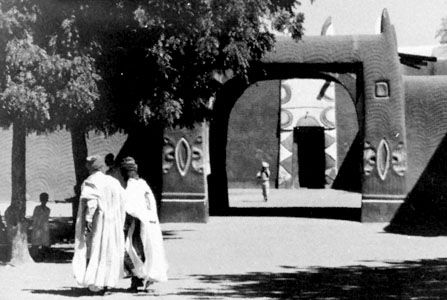 |
| This 18th Century West-African manuscript on mathematics is the type of material that Usman Dan Fodio studied during his youth. |
In this episode, we learn about the early life and education of the future Mujaddid, Usman Dan Fodio. While the exact location of his birth is unknown, Usman Dan Fodio's family had long roots in Kasar Hausa, with their migration into the area likely dating back at least 300 years. In his first years, Fodio's family moved to the city of Degel, a small town with a mid-sized Islamic University. His father, a wealthy merchant, ensured that Fodio received the best available education by hiring a series of private tutors. These tutors strongly influenced the young Fodio's views. One, a Hausa scholar named Jibril ibn Umar, was a controversial and radical figure in Sahelian Islamic academia. Umar had previously worked in the nearby sultanate of Agadez but had been kicked out of Agadez after the local sultan suspected that he was encouraging Muslims to rebel against their king. Umar was, in some ways, even too radical for his young student, as Fodio disagreed with his teacher's unorthodox views on polygamy, how to view Muslims who struggled with following the faith's rules, and other matters of Islamic law.
Alongside Umar, numerous scholars and teachers played a role in influencing the views of Fodio on matters of Islamic law and theology. Around this time, he was also initiated into the Qadri Sufi order, a major Sufi organization active in multiple regions throughout the Islamic world. By the time he completed his education, Fodio was considered educated enough to begin teaching in his own right. He worked as an iterant scholar, traveling from school to school and into rural villages to spread Islamic education. During this time, Fodio began to develop the beginnings of what would eventually become a major following. This early following was the first step in the formation of the Jamaa, the close followers of Usman Dan Fodio who would eventually serve as his revolutionary vanguard.
At first, Fodio tried hard to brand his teachings as ostensibly apolitical, avoiding criticism of specific kings or nobles and refusing to attend in-person meetings with these elites. At the time, the elites that ruled Degel were subservient to the most powerful Hausa kingdom of its era: the Kingdom of Gobir. Since before the birth of Fodio, Gobir enjoyed a long period of gradual empowerment at the expense of its neighbors. Surrounded by warlike enemies on all sides, the Hausa of Gobir had been forced to develop their own martial culture.
 |
| An example of lifida - the quilted armor worn by mounted noble cavalry in the eastern Sahel |
The kings of Gobir used this army to become a center of local power in their own right. Throughout the mid to late 18th century, Gobir's armies overwhelmed several of their neighbors, including the equally martial kingdoms of Zamfara and Kebbi. Gobir armies also raided south and east, extracting tribute from the kingdom of Bornu, as well as fellow Hausa cities like Kano, Katsina, Zazzau, and more.
 |
| Map of Kasar Hausa (purple) and its surrounding kingdoms (blue) |





